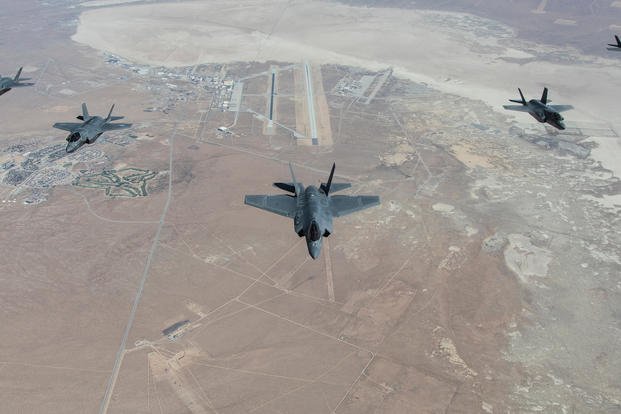When the U.S. Air Force gets its first F-35 Lightning II distributed mission training simulator system at Nellis Air Force Base, Nevada, this spring, pilots will have the ability to fly virtually as a group, alongside other aircraft, and practice exchanging information across a network, according to Lockheed Martin officials.
"When the F-35 [deploys to] a fight, we know it's not going by itself," said Chauncey McIntosh, vice president of F-35 Training and Logistics for Lockheed. McIntosh spoke during the Interservice/Industry Training, Simulation and Education Conference (I/ITSEC) conference in Orlando, Florida, on Tuesday.
"So by allowing our ... warfighters to really bring in all the other assets in a virtual environment and practice that, to ensure they get high-end training in these dense, immersive environments, [it] is going to be a game changer," he added.
McIntosh said the distributed mission training simulator, or DMT, has been in testing for months, and is in the final stages of integration before the technology is introduced in the spring.
Related: F-35 Testing Delays Continue, Even as Aircraft Has Made Its Combat Debut
"It's not just F-35-to-F-35; it's F-35 to anything that we can bring in a virtual reality environment to the network ... regardless of where it's located," he said.
According to the company, the simulator "creates interoperability across military platforms for continuation training and large force exercise."
"We expect this capability will be used in Virtual Flag exercises, allowing warfighters to practice complex training scenarios with other platforms virtually for integrated training operations," Lockheed said in a statement to Military.com.
The Air Force will be the first to use the technology, with the expectation that it will continue to be rolled out "throughout the F-35 enterprise" in the future, Lockheed officials added.
The Defense Department has put an emphasis on group training, with other services attempting their own digital training initiatives.
For example, a priority for the Army has been the synthetic training environment, also known as the STE.
Engineers collect data to reconstruct cities, mountainsides, bunkers etc. to more accurately represent what soldiers will experience in the STE, thus getting a more authentic representation of what they may face in combat.
The plan is for the STE to develop to a point that squads can operate together in training, facing virtual high-end threats.
However, it's unclear how soon that level of training will be realized.
During the annual Association of the U.S. Army Annual Meeting and Exposition in October, Maj. Gen. Maria Gervais, the STE cross-functional team director, said elements of the STE were in jeopardy given ongoing negotiations between lawmakers over the next fiscal budget.
"Once we see the final number, we'll understand the impact" on making STE operational, Gervais said at the time.
-- Oriana Pawlyk can be reached at oriana.pawlyk@military.com. Follow her on Twitter at @Oriana0214.
Read more: Raytheon Unveils Platoon-Sized Infantry Combat Simulator














